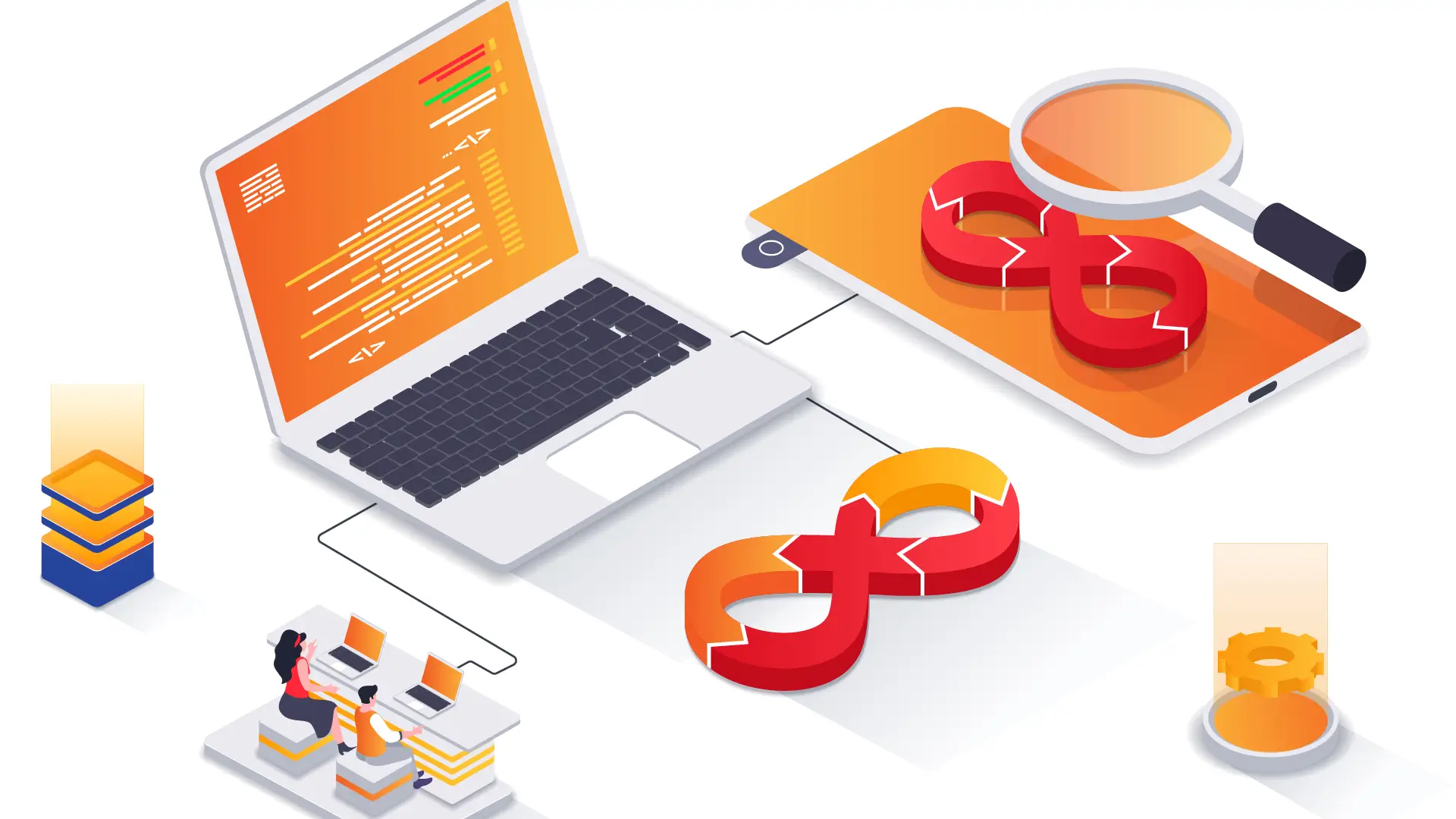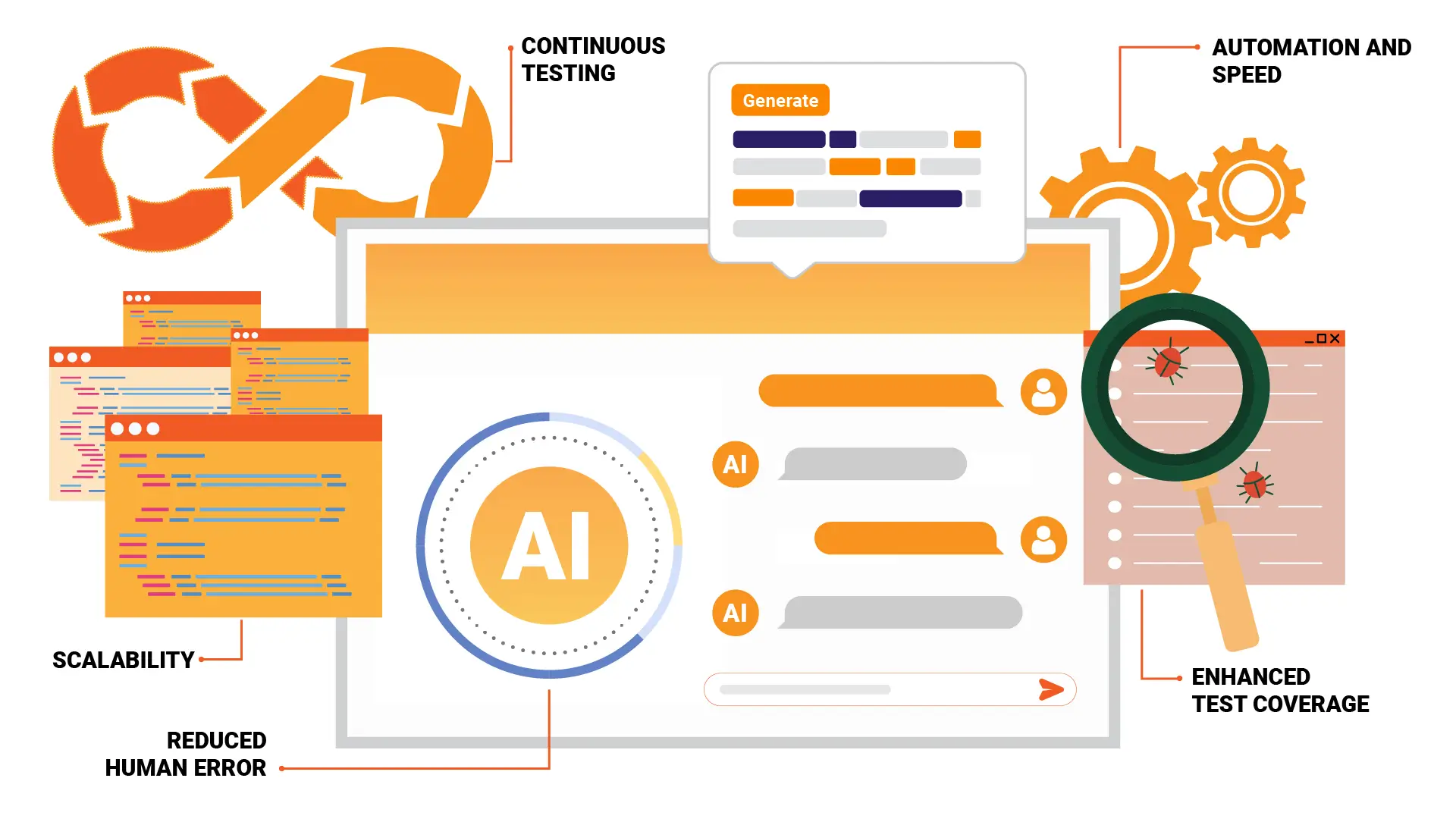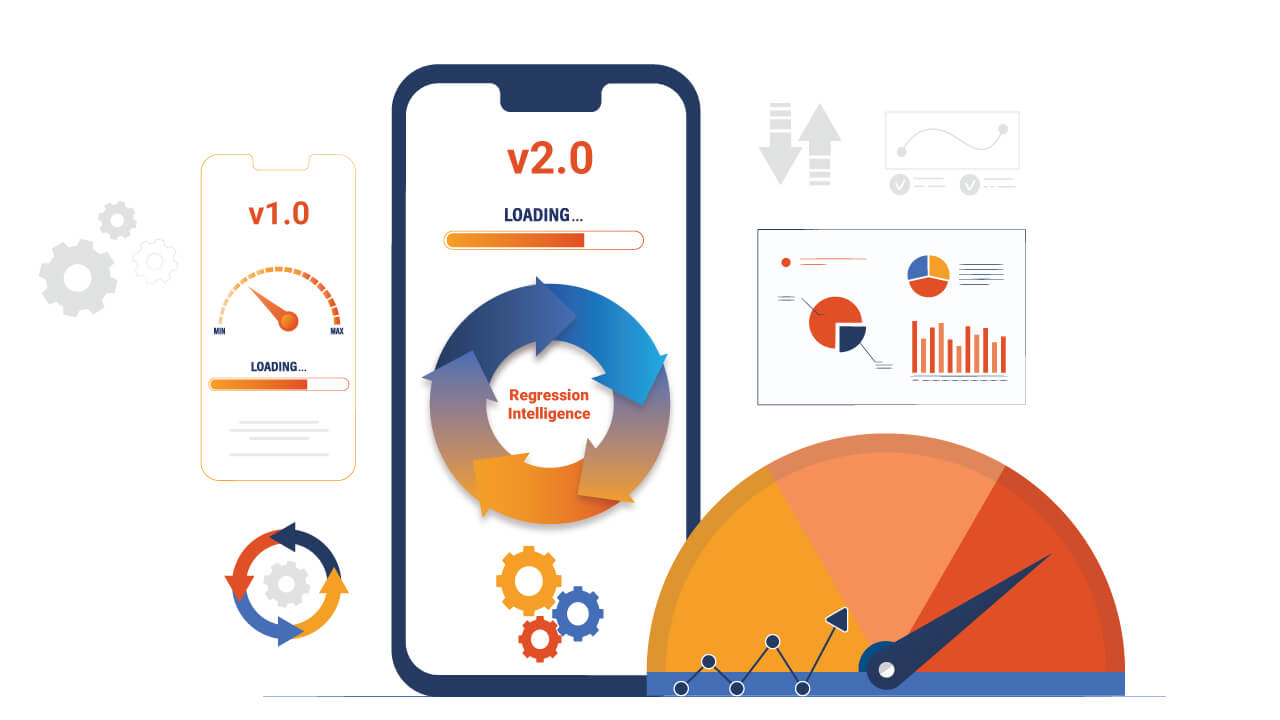Introduction
In software development, testing is essential for ensuring that the software operates as intended and fulfills the needs of its users. However, testing can be time-consuming and susceptible to errors, potentially compromising software quality. Continuous Integration and Continuous Delivery (CI/CD) step in here.
CI/CD is a software development approach aimed at efficiently delivering high-quality software to customers. It comprises two key elements: Continuous Integration (CI) and Continuous Delivery (CD). While CI/CD is commonly associated with development and deployment phases, its implementation in testing can significantly enhance overall software quality.
The Role of Continuous Testing in Software Development
Continuous testing software integrates automated feedback throughout the software development lifecycle, enhancing deployment management efficiency. It serves as a crucial component driving the effectiveness of CI/CD processes, accelerating SDLC timelines by improving code quality, minimizing errors, and streamlining DevOps operations.
Incorporating continuous testing ensures that critical end-to-end processes undergo thorough and frequent validation, offering organizations confidence in their functionality. It works synergistically with continuous integration, which is particularly beneficial in large organizations with numerous interconnected systems and multiple stakeholders making changes.
For instance, changes in various systems, such as front-end web storefronts, ERP systems handling transactions, and legacy mainframes, can pose risks to end-to-end business processes. Continuous testing mitigates these risks, reducing the likelihood of production disruptions due to changes in any part of the system.
Diverse Approaches to Continuous Testing
Continuous testing encompasses a range of methodologies to ensure software's reliability, security, performance, and usability. These methodologies include:
- Shift-Left Testing: Prioritizing early testing in the software development lifecycle to mitigate challenges during later stages.
- Shift-Right Testing: Focusing on end-stage testing to enhance user experience, performance, failure tolerance, and functionality.
- Smoke Tests: Quick screenings, manual or automated, to identify glaring flaws in software swiftly.
- Unit Testing: Checking small-scale aspects like stress, load, or memory leaks in early development to catch potential issues.
- Integration and Messaging Testing: Verifying collaboration errors between software modules, often by virtualizing missing dependencies.
- Performance Testing: Evaluating application performance, including system integration, to assess overall solution performance in production environments.
- Functional Testing: Confirming user experience alignment and functional workflow execution, while non-functional testing focuses on performance and scalability.
- Regression Testing: Ensuring no adverse changes after error corrections and maintaining system performance.
- User-Acceptance Testing: Assessing real-world application usage by a subset of intended users, exemplified by beta testing.
Advantages of Continuous Testing
Continuous testing software offers numerous benefits to organizations:
- Risk Mitigation: By continuously running comprehensive tests, the risk of small changes causing significant failures across related processes is significantly reduced. This ensures the stability and reliability of the production environment.
- Efficiency and Productivity: Continuous testing enhances efficiency by allowing organizations to conduct multiple automated tests throughout the software development lifecycle (SDLC). Teams can address errors early, accelerating development timelines and enabling quicker product releases.
- Time and Cost Savings: Identifying and resolving issues at any stage of development can save considerable time and resources. Continuous testing streamlines the development process, reducing the time to market and improving overall efficiency.
- Improved Quality and Speed: Continuous testing integrated into DevOps workflows enhances the speed and quality of builds. Timely feedback loops facilitate the creation of high-quality applications.
- Ease of Implementation: Continuous testing can be seamlessly implemented across all teams. QA experts can efficiently address end-user concerns, regardless of the complexity of the setup.
By embracing these continuous testing benefits, organizations can mitigate risks, improve efficiency, and deliver high-quality software products more effectively.
Read more: Mastering Continuous Testing: A Definitive Guide to Seamless Software Delivery
Essential Components of Effective Continuous Testing
To establish an effective continuous testing framework, it's crucial to adopt a scalable test automation approach based on the testing pyramid advocated by Agile expert Martin Fowler and defined by Agile author Mike Cohn. This pyramid consists of three key elements:
- Unit and Component Tests: Found at the base of the pyramid, these tests are isolated and executed quickly. They provide comprehensive coverage of code functionality, ensuring high-quality code.
- Service Integration or API Testing: Positioned in the middle of the pyramid, these tests validate system functionality and take longer to execute. They serve as the "sweet spot" for functional test automation.
- UI Testing: Located at the top of the pyramid, UI testing is slower and involves fewer tests. It requires the application to be at an advanced development stage.
Continuous testing relies on these elements to drive its effectiveness:
- Phase 1 Benefits: Continuous testing enables the early identification and remediation of regressions and vulnerabilities, delivering immediate value to organizations.
- Phase 2 Evolution: After establishing functional and unit tests and utilizing service virtualization for regression tests, organizations can shift focus to non-functional requirements such as security and performance.
Here's how continuous testing facilitates the shift-left approach for performance testing:
- Service Virtualization: Isolate system components and eliminate performance bottlenecks in the test infrastructure.
- Load Testing: Utilize existing API tests to generate load on the system.
- Continuous Integration Integration (CI): Integrate performance tests into the CI pipeline and execute them continuously.
By leveraging continuous testing and test-driven development, organizations can derive more excellent value from their testing efforts and enhance software quality.
Effective Strategies for Continuous Testing Success
- Commitment to Quality Delivery: Success in continuous testing hinges on a collective responsibility to deliver the highest quality. Collaboration among development, testing, and non-technical teams fosters a culture of continuous testing.
- Testing at Every Stage: Testing at the early stages of the development cycle allows for early bug detection, reducing costs compared to fixing issues in production. Testing is foundational to ensure the code operates as intended with each update.
- Monitoring with Analytics: Utilize data analytics to monitor the entire development cycle. Analyzing test performance helps identify bottlenecks and quality issues in real time, enabling timely updates for improved quality and faster releases.
- Comprehensive Testing Platform: Choose a testing platform with extensive coverage and flexibility to optimize customer experiences. Empower development and QA teams to perfect digital experiences for all customers, ensuring thorough testing and enhanced quality.
Also read: How to Boost Performance with Continuous Testing in DevOps
Challenges of Continuous Testing Implementation
Implementing continuous testing, despite its significant advantages, poses distinct challenges for software development teams:
- Integration with DevOps: Enhancements in tools and training are often necessary to effectively integrate continuous testing within Agile and DevOps frameworks.
- Cultural Shift: Embracing continuous testing may require a substantial cultural change, especially for teams accustomed to traditional development and testing processes.
- Testing Strategy Updates: Overreliance on conventional testing methods and inadequate test data management can hinder the efficacy of continuous testing, necessitating a shift in testing strategies.
- Regular Code Integration: Developers who infrequently integrate their code risks issues such as duplicate coding efforts and incompatible code, leading to defects.
- Test Environment Management: Ensuring compatibility between test environments and the code repository is imperative for seamless testing of the latest code changes.
- Production Environment Alignment: Vital alignment between production and test environments is crucial to ensure thorough testing of all software aspects.
Overview of Continuous Testing Tools
Continuous Testing tools have flooded the market, each offering unique features to streamline testing processes and accelerate software delivery. These tools include test automation, performance monitoring, code analysis, and defect tracking.
Among these tools, HeadSpin stands out as a reliable companion for development teams. Its intuitive interface, robust features, and seamless integration capabilities empower developers to orchestrate comprehensive test suites efficiently, ensuring accelerated software delivery without compromising quality.
Top Software Testing Tools
In addition to Continuous Testing tools, various top-tier software testing tools have garnered acclaim for their ability to uphold software quality across multiple domains. From functional and load testing to security and accessibility testing, these tools provide development teams with capabilities to identify and mitigate vulnerabilities, optimize performance, and enhance user experience.
Leading the pack in the software testing tools landscape is HeadSpin, renowned for its versatility and reliability in optimizing software quality across various testing requirements. Leveraging HeadSpin's comprehensive suite of testing capabilities, development teams can fortify their applications against vulnerabilities, ensure optimal performance, and deliver exceptional user experiences.
Advancing Continuous Testing with HeadSpin: A Comprehensive Review
The core elements of continuous automation, integration, and delivery are essential in enterprise continuous testing. HeadSpin's Testing Platform aligns strategically with these components, offering a seamless continuous testing environment spanning mobile, web, IoT, and 5G technologies. Positioned as a premier tool for continuous testing, HeadSpin boasts comprehensive capabilities, including continuous performance, functional, and load testing.
HeadSpin's Contribution to Agile and DevOps Transformation:
- Quick Feedback: HeadSpin facilitates rapid feedback loops by providing real-time insights into application performance across various devices, networks, and locations.
- Real-time Environments: With a global device infrastructure, HeadSpin creates diverse real-world testing environments, ensuring thorough and accurate testing across scenarios for seamless application functioning.
- Continuous Integration: By seamlessly integrating with Continuous Integration (CI) pipelines, HeadSpin enables automated testing at each integration point, ensuring consistent and timely evaluation of application changes.
- Reduced Maintenance Effort: HeadSpin streamlines maintenance efforts through a centralized testing infrastructure, automating routine tasks, minimizing manual intervention, and optimizing resource allocation and productivity.
- Actionable Insights: Leveraging AI-driven insights, HeadSpin enables teams to quickly identify issues, make informed decisions, and prioritize improvements, enhancing overall application quality and performance.
- Test Prioritization: HeadSpin empowers teams to intelligently prioritize tests based on critical business requirements and user scenarios, ensuring impactful and relevant tests are executed first, thus optimizing testing efforts.
- Test Automation: Facilitating seamless and continuous test automation, HeadSpin allows teams to automate numerous test cases across diverse devices, platforms, and networks, ensuring consistent and reliable testing outcomes.
By leveraging these capabilities, HeadSpin enables organizations to achieve a harmonious balance between speed, quality, and agility in their software development processes, ultimately delivering superior products to market efficiently and effectively.
What's Next?
Continuous testing has become essential for businesses looking to retain a competitive advantage. Adopting the right test automation tools and seamless integration is crucial for establishing an effective and efficient delivery pipeline.
Leading this evolution is HeadSpin, whose core product serves as a cornerstone for companies spanning diverse industries in their pursuit of continuous testing implementation. The HeadSpin Platform offers a versatile solution catering to various testing needs—from functional testing to performance and regression testing. Through HeadSpin's continuous testing model, organizations can significantly reduce costs, accelerate time-to-market, and, most importantly, focus on delivering enhanced customer value.
FAQs
Q1. How does continuous integration contribute to enhancing software quality?
Ans: Continuous integration automates building and running unit tests on new code changes, promptly detecting errors. It involves the software release process's automated build and unit testing stages, triggering every committed revision.
Q2. What role does continuous integration play in quality assurance (QA)?
Ans: Continuous Integration (CI) in QA involves developers frequently integrating code into a shared repository, ideally multiple times daily. Automated builds and tests verify each integration, ensuring code reliability and quality.



























-1280X720-Final-2.jpg)










